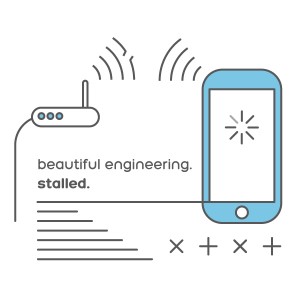

Remember the year 2001? Tony Blair was Prime Minister. Liverpool won the UEFA cup for the first time in 17 years. Jeffrey Archer went to jail. More importantly (unless you’re a Liverpool fan or Jeffrey Archer), the fastest WiFi speed available was 11Mpbs. But that was fine – because in 2001, your mobile phone did nothing more than make a phone call and you’d never heard of an iPhone or an iPad.
What about 2004? Tony Blair was still prime minister. Jeffrey Archer was still in jail. But WiFi speeds increased to a massive (not really) 54Mbps. But that was still enough because we still didn’t have wireless mobile devices – in fact, 1.5 billion of us were busy learning the abbreviations of our newest innovation on our mobiles – texting.
Gr8.
Lets fast forward to 2010, by which time we had not only heard of an iPhone – 47 million of us bought one. iPads were also born. 15 million of us bought one in this year. Smartphones and tablets were being released by Samsung, Blackberry and others and with those devices came apps and the ability to use the internet while mobile.
We had been accessing internet over WiFi for years with our laptops. The difference was that, when the WiFi was slow or unreliable, we could just plug in the Ethernet cable. But where do you plug in the Ethernet cable to your iPhone or tablet?
You can’t.
So WiFi had to get a lot faster and a lot more reliable. Cisco developed technologies like CleanAir and Clientlink to do just that, and the WiFi speeds jumped to 450Mpbs. So far, so good. Except that was 4 years ago, and since then, growth in wireless devices has been exponential.
So lets look at the reality we are dealing with today. Remember how I said Apple sold 15 million iPads in 2010. Well, they sold almost twice that many – 26 million – in just the first quarter of 2014, not to mention 43.7 million iPhones in the same quarter. And, as amazing as that stat is, Apple aren’t even the market leader.
Gartner tell us that this year alone, we will buy 2.4 Billion smartphones, PC’s and tablets. Or another way of saying that is that by the end of this year, there will be 2.4 billion new wireless devices joining our networks.

And like so many things in life, it’s not what you’ve got but what you do with it that counts. And what do we do with our mobile wireless devices? For starters, we watch a lot of video; 6 billion hours of video are watched on YouTube every month – 40% on a mobile device.
We also send a lot of video using mobiles. Last year we sent more data from mobile phones than the size of the entire internet back in 2001. By 2018 mobile data is predicted to double again. And that’s just smartphones – consider that tablets generate more than twice as much data traffic as our phones.
So, it’s easy to see that 450Mbps is not going to sustain us for long, right?
Enter 802.11ac; Already standard on Samsung. Hotly anticipated on the iPhone6. 802.11ac gives us WiFi speeds up to 1Gbps, the same speed as Fixed Ethernet cables. It’s the enabling connection for the continued growth of our mobile, wireless-only devices.
If there is one key takeaway from this article, it’s this – you cannot realise the full benefits of these faster handheld devices unless you provide the 802.11ac wireless connectivity they were designed for.
Because the speed of a network is limited to the weakest link, both the wireless network (AP’s and Controllers) AND the client devices (i.e., tablets, smartphones, MacBooks, laptops, etc) have to be 802.11ac compatible. So a user won’t experience the benefit of a faster, 802.11ac device like the iPhone6 or Samsung Galaxy S5 unless they also have an 802.11ac wireless network.
And that’s where Cisco comes in.
In basic terms, a Cisco 802.11ac network:-
- Provides 1.3Gbps WiFi Wave 1, and will provide 3.5Gbps WiFi WAVE 2 (estimated late 2015, not committed).
- Improves the number of clients that can be served by a Cisco Wireless Access Point (AP). When combined with HDX in the Cisco 802.11ac access points, we can service more clients and give a better user experience.
- Gives more bandwidth for a higher number of parallel video streams. When combined with the Videostream capability of the Cisco Wireless LAN Controller, the customer gains a level of control, resource allocation and user experience which is normally experienced with a wired connection.
- Gives faster file downloads and email sync
- Extends the battery life of the client device (because rather the 11ac protocol enables the device’s WiFi interface to wake up, exchange data with the AP, then go back to sleep much quicker than previously).
- Operates on 5GHz, which is a “less crowded” band than previous protocols which operate in the 2.4Ghz band. The 2.4Ghz band is also shared with other non-WiFi devices such as bluetooth, microwave ovens, CCTV cameras, etc. The 5Ghz band is not.
- Most customers with older WiFi networks based on the 802.11 a, g, or n protocols, will thus likely be operating in the 2.4Ghz range. These customers can either:
- Build an overlay 802.11ac network for the 11ac-compatible devices. This will also give benefit to the users with older clients (such as the iPad 2 or 3) which are not 11ac compatible, because the clients that ARE 802.11ac compatible will seamlessly connect to the 802.11ac network, freeing up bandwidth on the older 2.4Ghz network for those older client devices. However, Cisco 802.11ac AP’s are backwards compatible with the older client devices too, so this is not entirely necessary and customers can instead:
- Replace their wireless LAN with an 802.11ac wireless LAN, which is fully backwards compatible with the older protocols, so existing users with older client devices that are not 802.11ac compatible will still be fully supported and may in fact see a performance improvement (though obviously, they won’t get the full benefit of 11ac until they upgrade their device).
A lot has changed since 2001, and even since 2010. To support the mobile video and data growth we have seen, and to prepare for it’s further predicted growth, we have to move move forward to WiFi speeds needed today and in future, and away from the slower wireless speeds of previous years. We need a wireless LAN that can keep up.
802.11ac is how we do that.
Thanks to Brett Martin and Jason Tyler, Wireless Experts in the UK&I EN team

1 Comments
Wifi needs to keep pace will they LAN. To provide users with high quality experience. Glad to see the Cisco has the answer.